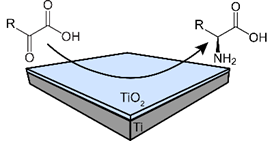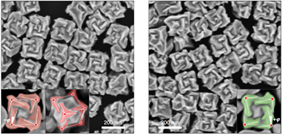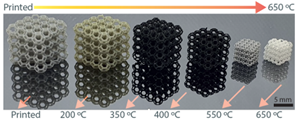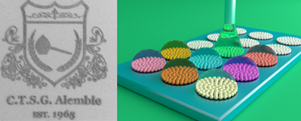Mesoscale chemical systems bridge the gap between chemical processes across multiple scales. In many chemical processes, atomic, molecular, photonic, and electronic events occur in femtoseconds on a nanometer-size surface site. This nanoscale activity is connected to processes running in seconds at the millimeter scales in a liquid or gas. The crucial link between these two scales is the mesoscale phenomena. For example, consider constructing 3D structures with specific characteristics to control chemical transport issues or reaction networks in a gas or liquid… MCS has several projects within materials, chemical processes, or both.
Contact: Arturo Susarrey (a.susarreyarce@utwente.nl)
| Electrochemical synthesis Using 3D electrodes, we are looking to tame mass transport issues during electrosynthesis. An exciting reaction is an amino acid electrochemical synthesis. Instead of environmentally harmful methods involving hazardous gases and solvents, we look for a sustainable synthesis route. In this example, we use biomass-derivable α-keto acids to α-amino acids at ambient conditions. How? In water, use a zero-gap flow electrolyzer and via the electrocatalytic reductive amination (ERA) of the α-keto acids with hydroxylamine (NH2OH). Non-toxic and abundant TiO2/Ti felt electrocatalysts can be utilized, and the whole process can be driven by green electricity. To date, alanine has been produced. In this project, you will carry out: (i) Electrosynthesis or chiral amino acids using chiral nanoparticles. |
| Chiral separation Chiral separation involves separating enantiomers, i.e., mirror-image molecules. Techniques include chromatography, capillary electrophoresis, and crystallization, which are crucial in pharmaceuticals for drug development. However, how about separating enantiomers using light and nanoparticles? Before separation, we need your help synthesizing different types of chiral nanoparticles. In this project, you will carry out: (i) Synthesis of chiral nanoparticles using amino acid precursors, known to transfer their unique chirality characteristics to inorganic nanoparticles. |
| 3D structures for (photo)electrocatalysis A 3D-printing approach is used to fabricate the green bodies/precursor microarchitectures that, upon annealing, allow the production of hierarchical 3D hollow microarchitectures. The newly hollow printed microarchitecture is tested during the degradation of organic contaminants and for the production of H2. The design opens new horizons for spatially controlling interconnected networks, which can help direct (photo/electro)catalytic reactions. In this project, you will carry out: (i) 3D printing for the production of semiconductors for H2 production or water remediation. |
| Oscillation reactions in confined spaces Oscillating chemical reactions exhibit rhythmic changes in concentration over time. These dynamic processes, driven by feedback mechanisms, showcase periodic shifts between reactants and products, creating fascinating, colorful patterns during reaction kinetics. It is unknown if other chemical processes, like a droplet, might change when confined in small spaces. We look to understand how chemical reactions lead to a change when confined. You will: (i) Investigate chemical parameters that change in confined spaces by looking at color-change droplets. |
| Pick and play colloids for colorful patterns Spherical colloids form diverse crystal patterns due to interparticle forces. These arrangements exhibit unique geometries influenced by size and surface interactions. Similar to the Alembie logo (left image), we look to assemble a similar design but with colorful colloids. You will: (i) Investigate how to pattern colloids to encrypt information with colorful designs. |





